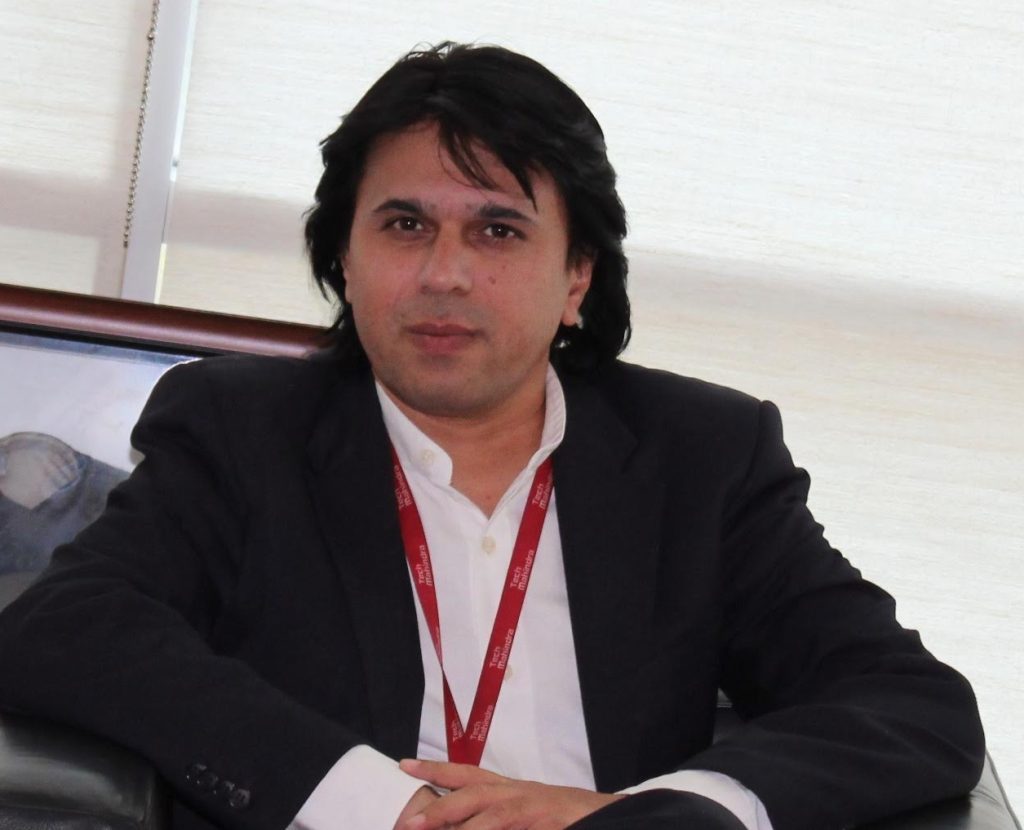f fad diets have left you frustrated, Cleveland-based fitness coach Harsha Pakhal offers five simple, sustainable nutrition hacks that actually stick. From ditching food labels to following the 80/20 rule, his approach focuses on building habits that improve energy, mood, and long-term health—without the guilt or quick-fix extremes.
The post Harsha Pakhal Tells Us About 5 Nutrition Hacks That Actually Stick appeared first on Green Prophet.
Tech Mahindra’s Sandeep Chadna
At this year’s World Green Economy Summit 2025, Tech Mahindra’s Chief Sustainability Officer, Sandeep Chandna, is not mincing words. In an exclusive conversation with Green Prophet, he insists that sustainability has outgrown its role as a corporate side-project. Forget box-ticking ESG reports — Chandna says the future belongs to companies bold enough to treat sustainability as their core strategy for innovation, resilience, and survival.
Why does this matter? Because Tech Mahindra isn’t just talking the talk. It’s the first Indian company to win the Terra Carta Seal from King Charles III, ranked #2 globally for IT services on the S&P Dow Jones Sustainability Indices, and is already cutting emissions with AI-powered tools and a growing renewable energy footprint. Chandna reveals how putting a price on carbon inside the company — $12 a ton — is changing investment decisions, and how platforms like i.GreenFinance are pushing banks and institutions toward measurable green impact.
For those still treating ESG as a PR exercise, this is a warning shot. Chandna’s message is clear: sustainability is no longer optional. It’s the new operating system for business — one that could define winners and losers in the decade ahead.
Green Prophet: At the World Green Economy Summit 2025, what key message will you be delivering to global sustainability leaders?
Sandeep Chandna – Chief Sustainability Officer, Tech Mahindra:
At the World Green Economy Summit 2025, our core message will be clear: sustainability must shift from being a compliance checkbox to a strategic, purpose-driven imperative that powers innovation, resilience, and inclusive growth. We stand at a critical inflection point where ESG is no longer a reporting exercise, it is the blueprint for future-ready enterprises. We want to spotlight how digital transformation, when purposefully aligned with climate and social goals, can catalyze systemic change. Tech Mahindra’s journey, from pioneering green IT to launching AI-powered sustainability platforms, demonstrates that technology is an enabler and a force multiplier. We will also advocate for cross-sector collaboration, urging leaders to move beyond silos and co-create solutions that honor both planetary boundaries and human aspirations.
How does Tech Mahindra’s role as the only Indian company with the Terra Carta Seal influence your global positioning in sustainability?
Being awarded the Terra Carta Seal by His Majesty King Charles III is both an honor and a mandate. It places Tech Mahindra among a select cohort of global companies recognized for credible, science-aligned transition strategies. As the First Indian recipient, it amplifies our voice in international sustainability dialogues and affirms our leadership in climate-conscious innovation. The Seal validates our commitment to nature-positive solutions, from smart infrastructure to green software. It also strengthens our engagement with standards and frameworks like the Global Reporting Initiative (GRI) 2021, Sustainability Accounting Standards Board (SASB), International Sustainability Standards Board’s (ISSB) IFRS S1 and S2 standards, Business Responsibility and Sustainability Reporting (BRSR), International Integrated Reporting Council (IIRC), Taskforce on Climate-related Financial Disclosures (TCFD), Taskforce on Nature-Related Financial Disclosures (TNFD), and Greenhouse Gas (GHG) Protocol standards. More than recognition, it is a call to action: to lead with integrity, scale impact, and inspire others across industries and borders.
You’ve been ranked #1 in India and #2 globally in the S&P Dow Jones Sustainability Indices for IT services. How do you translate such rankings into tangible real-world impact?
These rankings are a testament to our rigor and transparency across ESG dimensions, but their true value lies in how we operationalize them. At Tech Mahindra, we have embedded sustainability into the DNA of our business. From reducing Scope 1 and 2 emissions by over 31% since 2016 to sourcing 31% renewable energy across owned campuses, our actions speak louder than metrics. We have achieved Zero Waste to Landfill certification at key locations and implemented ESG-aligned procurement protocols. These outcomes benefit the environment, enhance stakeholder trust, drive cost efficiencies, and position us as a preferred partner for purpose-driven customers.
Can you share a project or initiative where your sustainability strategy delivered measurable results for both the business and the environment?
One of our most impactful initiatives has been the transition to renewable energy across our campuses. Through strategic investments in solar infrastructure and green power purchase agreements, we have achieved a 31% renewable energy mix at owned locations and nearly 23% globally. This has led to a 31% reduction in Scope 1 and 2 emissions compared to our 2016 baseline. Beyond environmental gains, the initiative has delivered tangible business benefits, lower operational costs, enhanced energy resilience, and stronger ESG credentials. Complementing this is our green mobility program, which promotes electric vehicle adoption and sustainable commuting, further reinforcing our commitment to climate-positive action.
With a goal of carbon neutrality by 2030 and net zero by 2035, what innovations or policies will be most critical in reaching these targets?
Achieving these ambitious milestones demands a holistic and forward-looking strategy. Our internal carbon pricing, currently set at $12 per metric ton, serves as a financial compass, guiding investments toward low-carbon alternatives. We are aggressively scaling renewable energy adoption, targeting 90% sourcing by 2030. Innovations such as AI-driven energy optimization, smart buildings, and digital twins are being deployed to enhance operational efficiency. Policy-wise, we are aligning with SBTi-approved Net Zero targets and embedding ESG criteria into procurement and vendor governance. These levers, technology, policy, and behavioral transformation are essential to decarbonizing our value chain while sustaining growth and competitiveness.
How is internal carbon pricing changing decision-making within Tech Mahindra?
Our internal carbon pricing mechanism has fundamentally reshaped how we evaluate investments and operational decisions. By assigning a tangible cost to carbon, $12 per metric ton, we have embedded climate risk into our financial modeling and strategic planning. This approach incentivizes low-carbon innovation, accelerates renewable energy adoption, and ensures that sustainability is a core consideration in everything from facility upgrades to supply chain choices. It is a cultural shift that reinforces our commitment to responsible growth and climate stewardship. It empowers teams to make decisions that are not only economically sound but environmentally aligned.
Could you elaborate on how platforms like i.Greenfinance are helping clients accelerate their own sustainability journeys?
AI platform for green finance
i.GreenFinance is a transformative platform that enables financial institutions to embed sustainability into their lending and investment decisions through automated ESG scoring with sector-specific KPI weighting. For instance, carbon emissions are prioritized in energy lending, while biodiversity and land-use practices take precedence in agriculture. These weights are fully adjustable to reflect regional requirements, regulatory frameworks, and institutional sustainability policies.
Built on an API-first architecture, the platform integrates seamlessly into existing Loan Origination Systems, enabling smart green loan underwriting where sustainability insights and ESG scores are embedded directly into credit decisioning workflows without disrupting core banking systems. Beyond origination, i.GreenFinance provides post-approval tracking of loan proceeds to ensure disbursed funds support their intended sustainable projects, from renewable energy deployment to green infrastructure upgrades. This delivers transparency and accountability for both lenders and borrowers.
The platform combines taxonomy mapping, feasibility reporting, and real-time analytics to provide comprehensive views of project viability and climate risk. These outputs are designed to support internal decision-making, helping lenders evaluate applications, monitor fund usage, and align portfolios with global sustainability standards.
With high configurability, i.GreenFinance adapts to each institution’s policies, product mix, and regional context. By making ESG performance sector-specific, customizable, auditable, and trackable across the loan lifecycle, the platform empowers institutions to move from intent to measurable impact, accelerating their journey toward responsible finance and net zero alignment.
What role will AI, IoT, and other emerging technologies play in driving sustainability transformations for global clients?
With the emergence of Generative AI, we’re solving sustainability’s most pressing challenges at unprecedented scale. i.GreenFinance exemplifies this innovation, delivering smart green loan underwriting, feasibility analysis, and real-time proceeds tracking that transforms how financial institutions approach sustainable lending.
Beyond finance, we’re tackling complex sustainability challenges using agentic AI across ESG reporting automation, dynamic materiality assessment, climate risk evaluation, supply chain assessments, and document intelligence. These solutions address a critical pain point for large enterprises, interoperability across multiple reporting regimes including CSRD, ISSB, SFDR, and regional taxonomies. Our platforms automatically harmonize data across frameworks, ensuring sustainability information is configurable, actionable, and audit ready.
IoT technology complements our AI capabilities by feeding real-time sensor data from assets, buildings, and infrastructure directly into our platforms. This integration enables continuous monitoring, predictive analytics, and early-warning systems for emissions tracking, energy efficiency optimization, and resource usage management—transforming raw operational data into actionable sustainability insights that drive immediate decision-making.
The convergence of AI and IoT creates intelligent sustainability ecosystems that provide 360-degree visibility into environmental performance. Organizations can now identify inefficiencies before they occur, optimize resource allocation in real-time, and demonstrate measurable progress toward sustainability goals with unprecedented precision.
Together, AI and IoT are redefining sustainability, making it smarter, faster, and measurable while empowering organizations to evolve from reactive compliance to proactive strategic foresight and value creation. This technological revolution enables businesses to anticipate risks, capitalize on opportunities, and accelerate their transformation toward sustainable operations.
Your first TNFD report integrates nature-related risks into corporate strategy. How will this shape future investments and operations?
Our TNFD-aligned disclosures mark a strategic evolution, from climate-centric reporting to nature-inclusive governance. By assessing dependencies on biodiversity, water, waste management and ecosystem services, we are embedding nature risk into investment decisions, site planning, and supply chain management. Future expansions will be evaluated for financial viability and ecological integrity. We are developing nature-positive KPIs and integrating them into our ESG dashboards, ensuring that regeneration is part of our strategy. Our proactive efforts to manage nature-related risks and seize opportunities reflect our dedication to creating long-term value for our stakeholders while safeguarding the environment. We understand that the journey towards sustainability is ongoing, and we are committed to continuously improving our practices and strategies to meet the evolving challenges of our global ecosystem. TNFD is helping us future-proof our business, align with planetary boundaries, and contribute meaningfully to global biodiversity goals.
Beyond corporate targets, what legacy do you hope Tech Mahindra’s sustainability strategy will leave for the industry and the planet?
We aspire to leave behind a legacy of transformation, where sustainability is a catalyst for systemic change. We want to demonstrate that purpose-driven technology can solve complex global challenges, from climate resilience to social equity. By embedding ESG into our core strategy, launching nature-positive platforms, and championing inclusive innovation, we aim to inspire a paradigm shift across industries. If we can help reframe sustainability as a source of value, trust, and regeneration, then our legacy will be one of leadership in building a better future for generations to come.
The post World Green Economy Summit 2025: Sandeep Chandna’s Mission to Make Sustainability Core to Business Strategy appeared first on Green Prophet.




